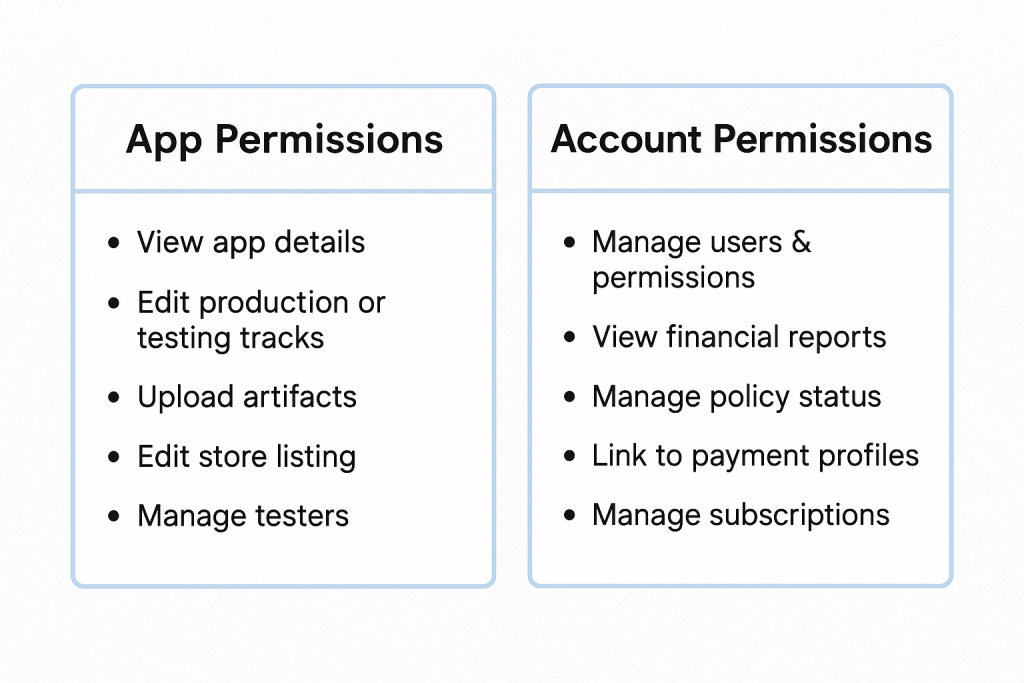Let’s break down the difference between App Permissions and Account Permissions in a simple, clear way:

🔑 Key Difference
| Type | Scope | Affects |
|---|---|---|
| App Permissions | Specific App(s) only | Controls what a user/group can do with a particular app |
| Account Permissions | Entire Play Console Account | Controls what a user/group can do at the account-level (all apps, settings, finance, policy, etc.) |
🧱 Think of It Like This:
- App Permissions = “What can you do to a specific app?”
- Account Permissions = “What can you do in the entire developer account or across all apps?”
📦 1. App Permissions (Granular, Per-App)
These permissions control what a user/group can do with individual apps.
For example, per app, you can grant permission to:
- View app details
- Edit production or testing tracks
- Upload artifacts (like APK/AAB)
- Edit store listing
- Manage testers
- View or respond to reviews
You can apply these permissions differently for each app in your account. So a group may have full access to App A, but read-only for App B.
💡 These are useful when your organization has multiple apps and different teams working on each.
🏛️ 2. Account Permissions (Global or Admin-Level)
These are higher-level permissions that apply across your Play Console account, not tied to a specific app.
Examples:
- Manage users & permissions (e.g., add/remove team members)
- View financial reports and earnings
- Manage policy status and appeals
- Link Developer Account to payment profiles
- Manage subscription & monetization settings globally
💡 These are ideal for owners, finance teams, legal, admins, or SREs handling compliance and account-level ops.
🔍 Use Case Example
Let’s say you’re managing a team of 3 groups:
| Group Name | App Permissions | Account Permissions |
|---|---|---|
| Developers | Full access to App A & B | None |
| Marketing | Store listing only for App B | None |
| Finance/Admins | No app-level access | Can view earnings & manage users |
🎯 Best Practices
- ✅ Give developers mostly app permissions
- ✅ Give legal/finance mostly account permissions
- ✅ Only give account permission to trusted roles (Owners, Admins)
- ✅ Use Groups to manage roles in bulk instead of assigning users individually
- ✅ Audit permissions frequently to avoid accidental exposure of sensitive data
⚠️ Important Note
Even if someone has App Permissions, they cannot manage other users unless they also have the “Account > Manage Users & Permissions” permission.

I’m a DevOps/SRE/DevSecOps/Cloud Expert passionate about sharing knowledge and experiences. I am working at Cotocus. I blog tech insights at DevOps School, travel stories at Holiday Landmark, stock market tips at Stocks Mantra, health and fitness guidance at My Medic Plus, product reviews at I reviewed , and SEO strategies at Wizbrand.
Please find my social handles as below;
Rajesh Kumar Personal Website
Rajesh Kumar at YOUTUBE
Rajesh Kumar at INSTAGRAM
Rajesh Kumar at X
Rajesh Kumar at FACEBOOK
Rajesh Kumar at LINKEDIN
Rajesh Kumar at PINTEREST
Rajesh Kumar at QUORA
Rajesh Kumar at WIZBRAND